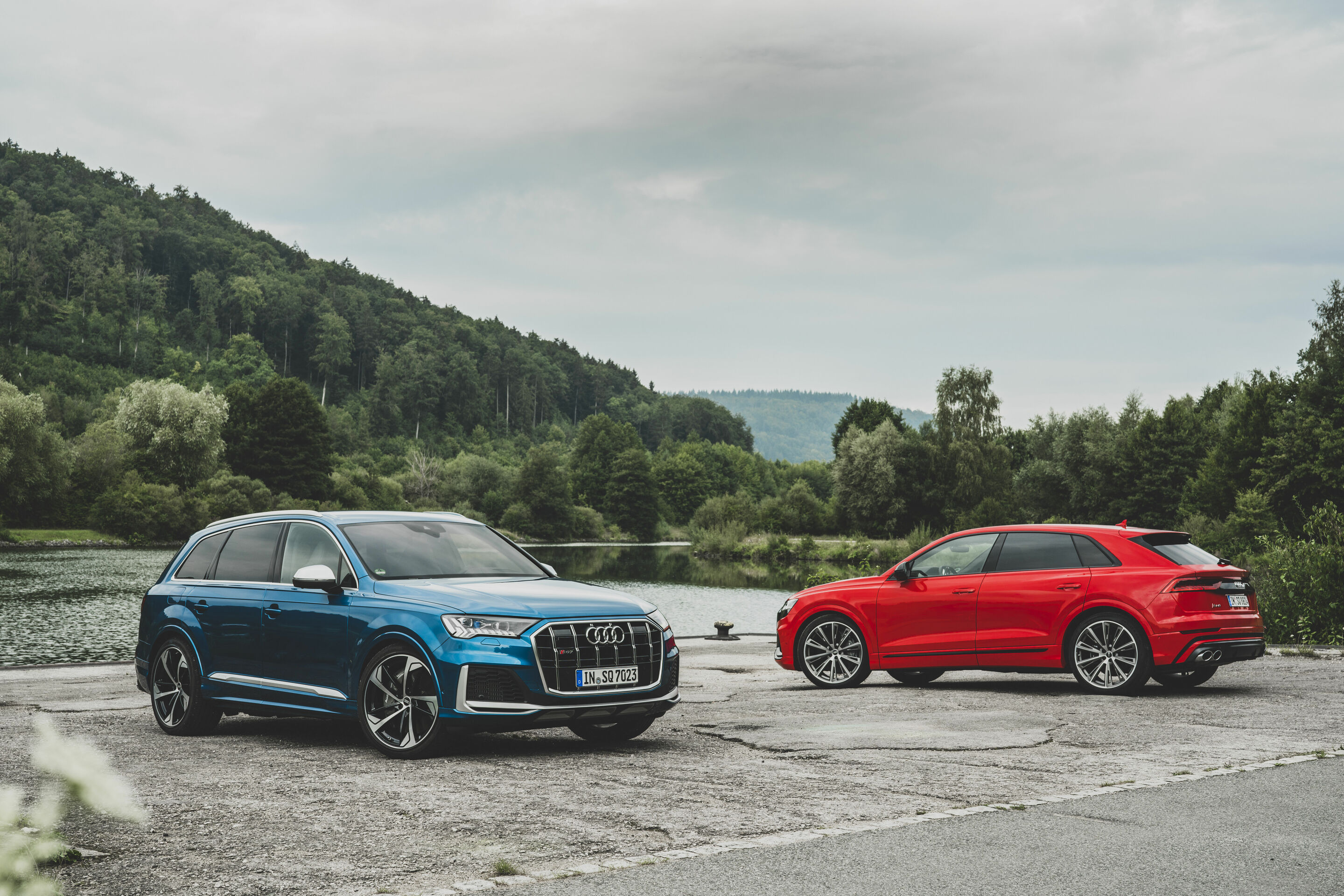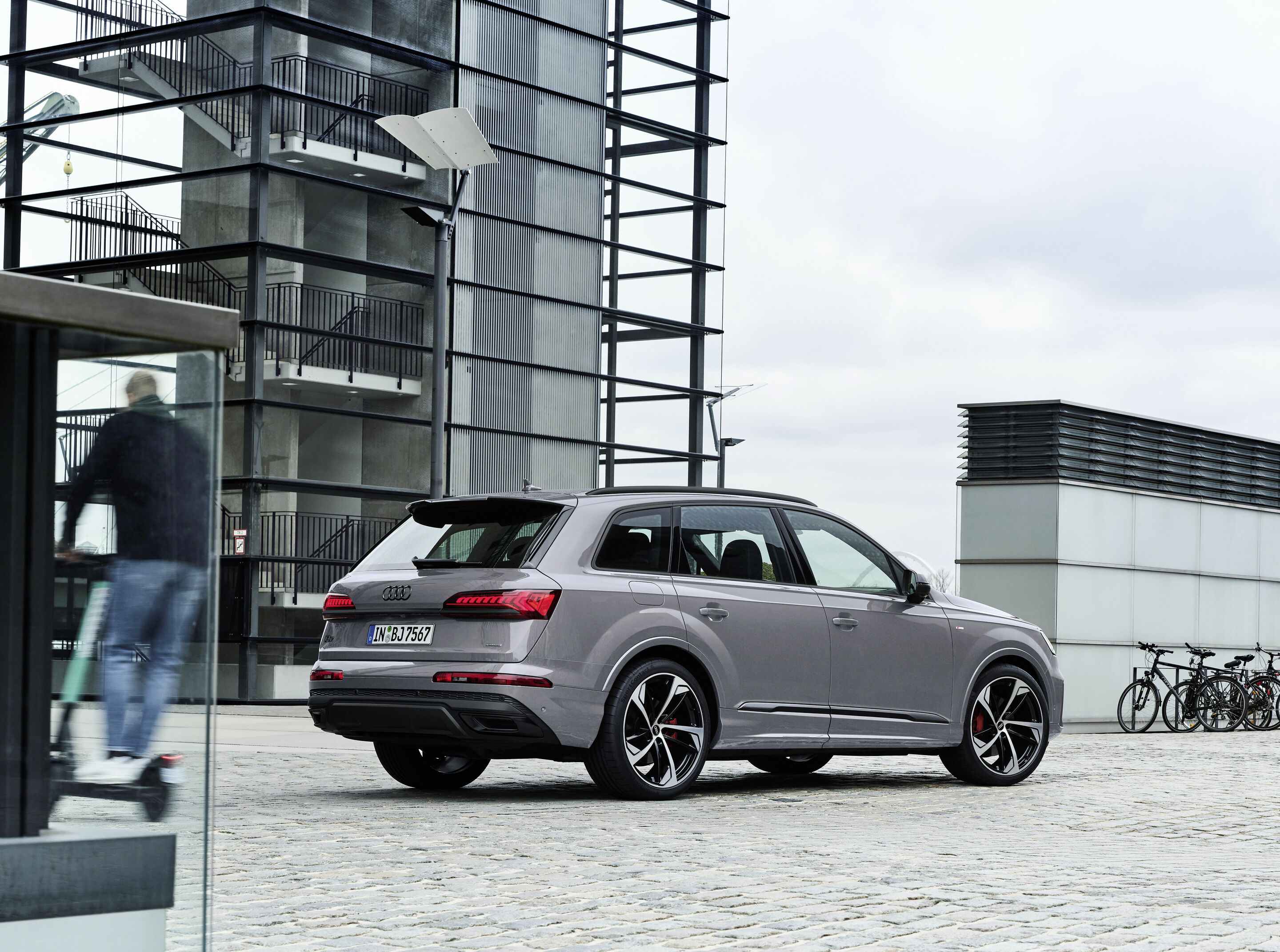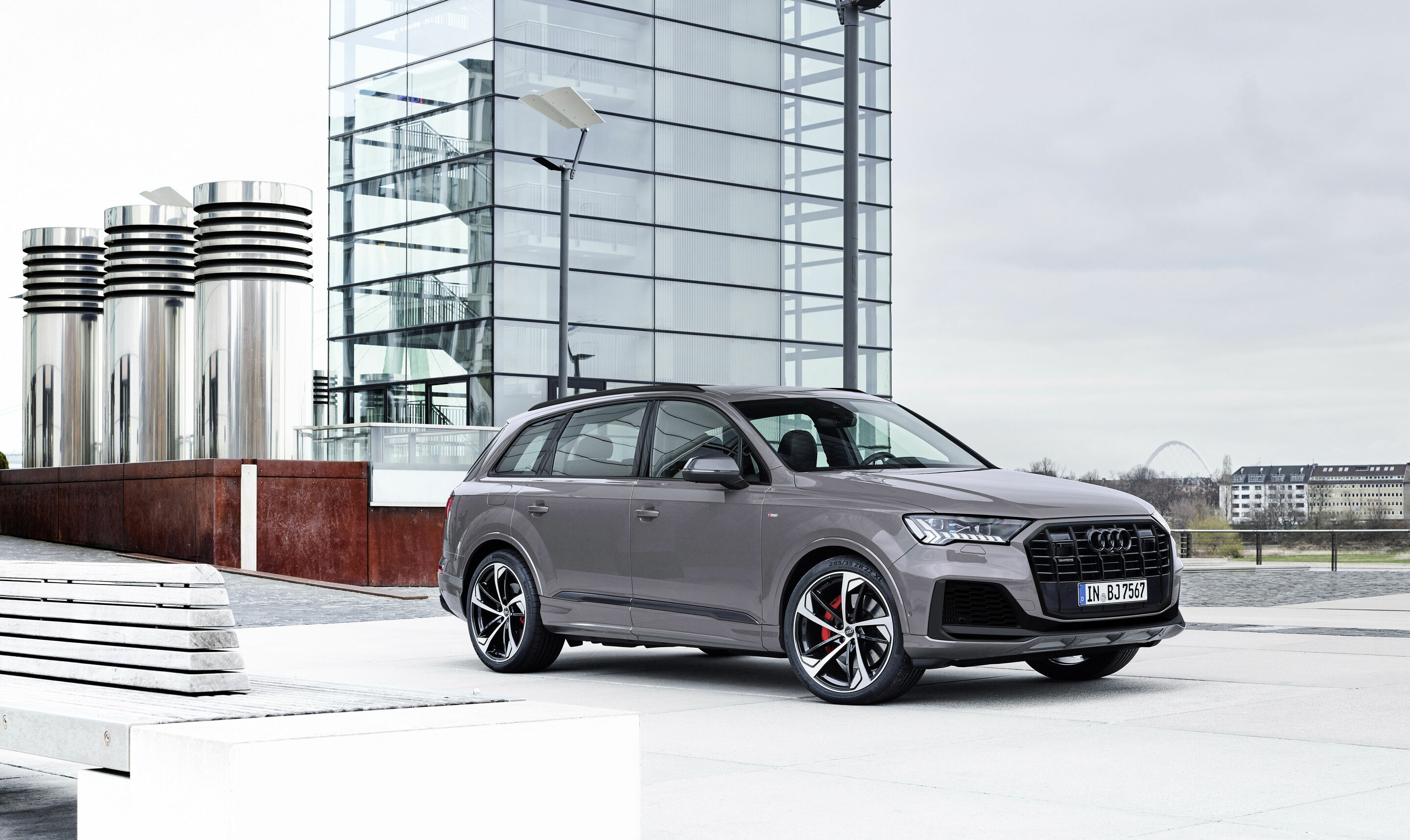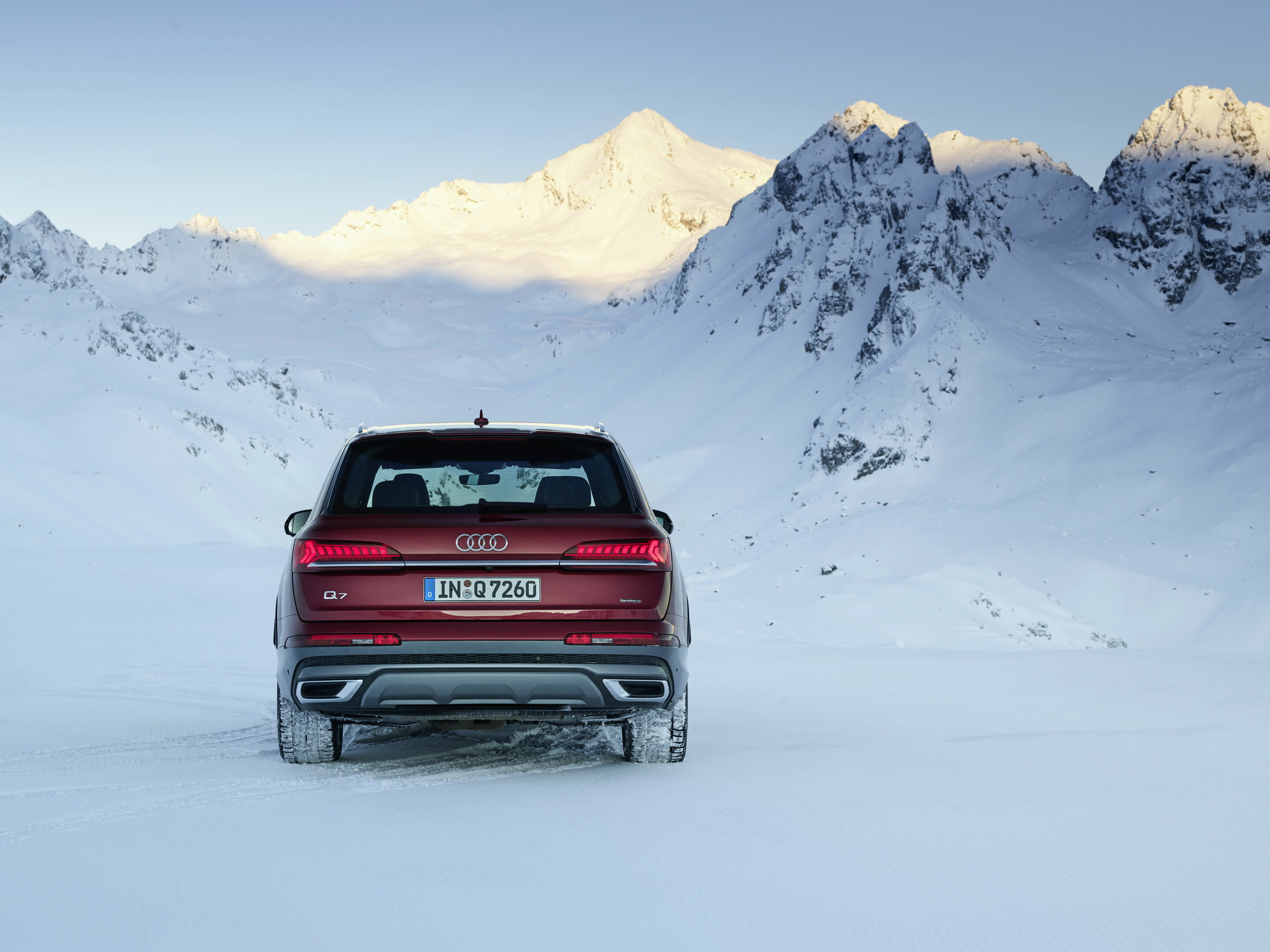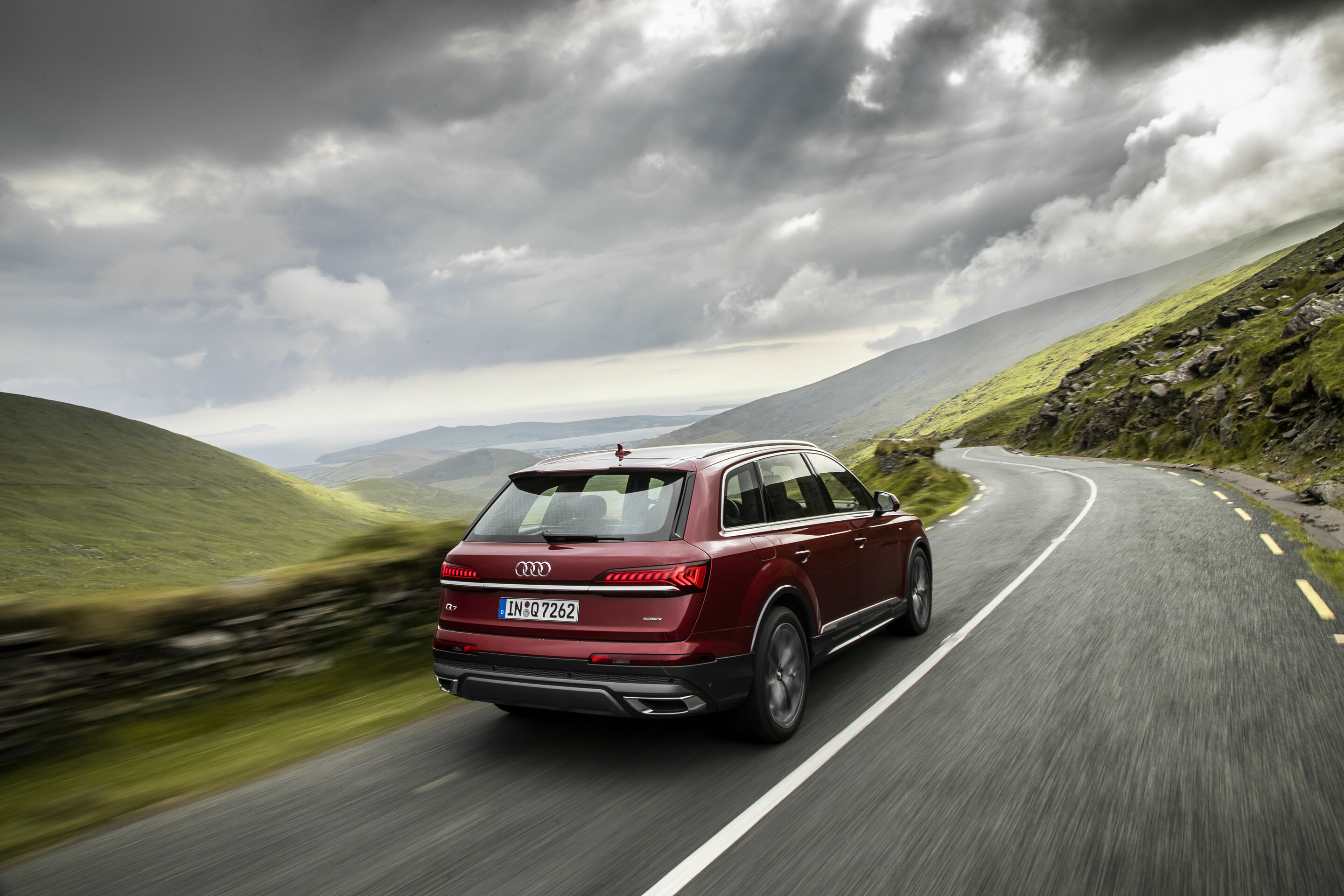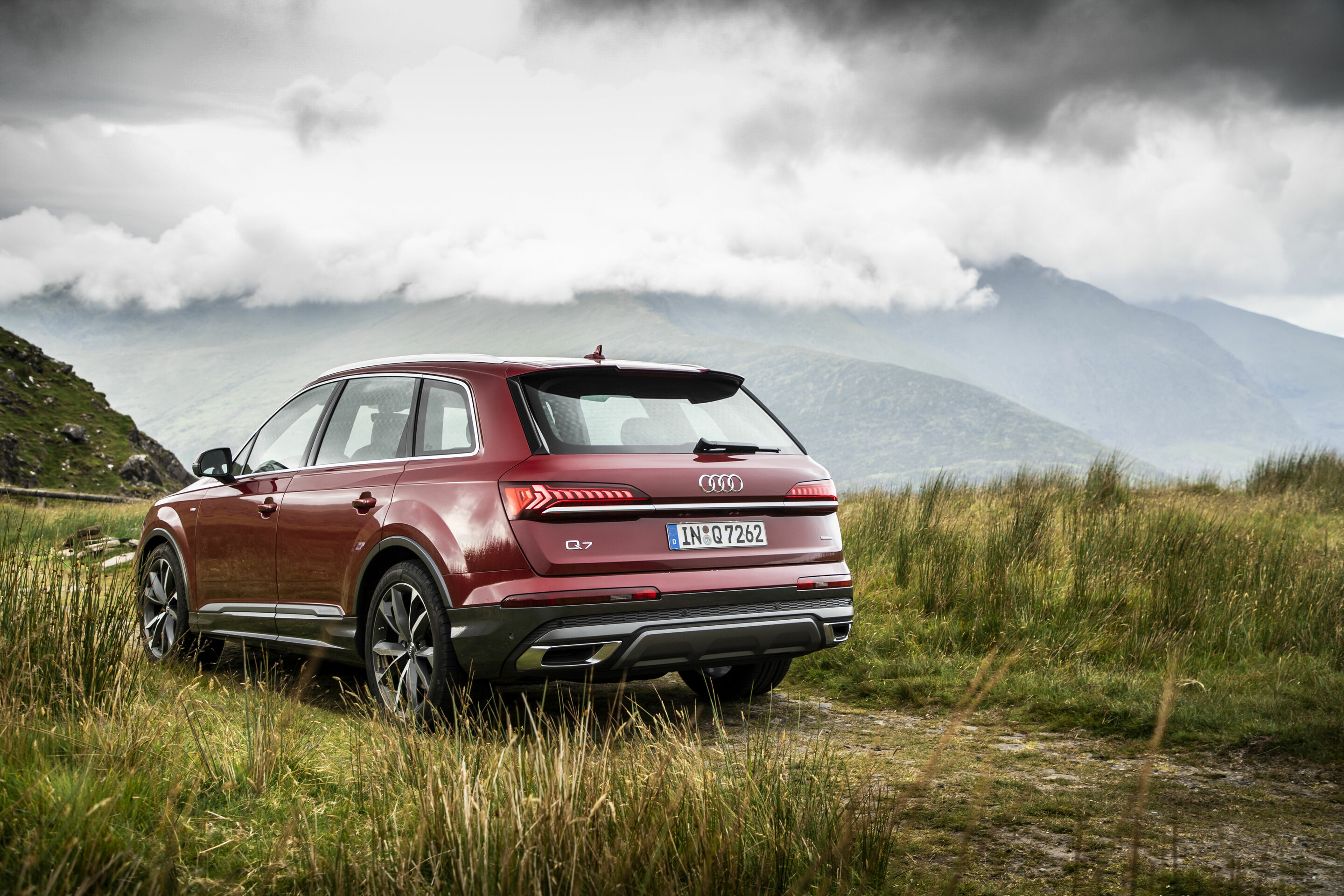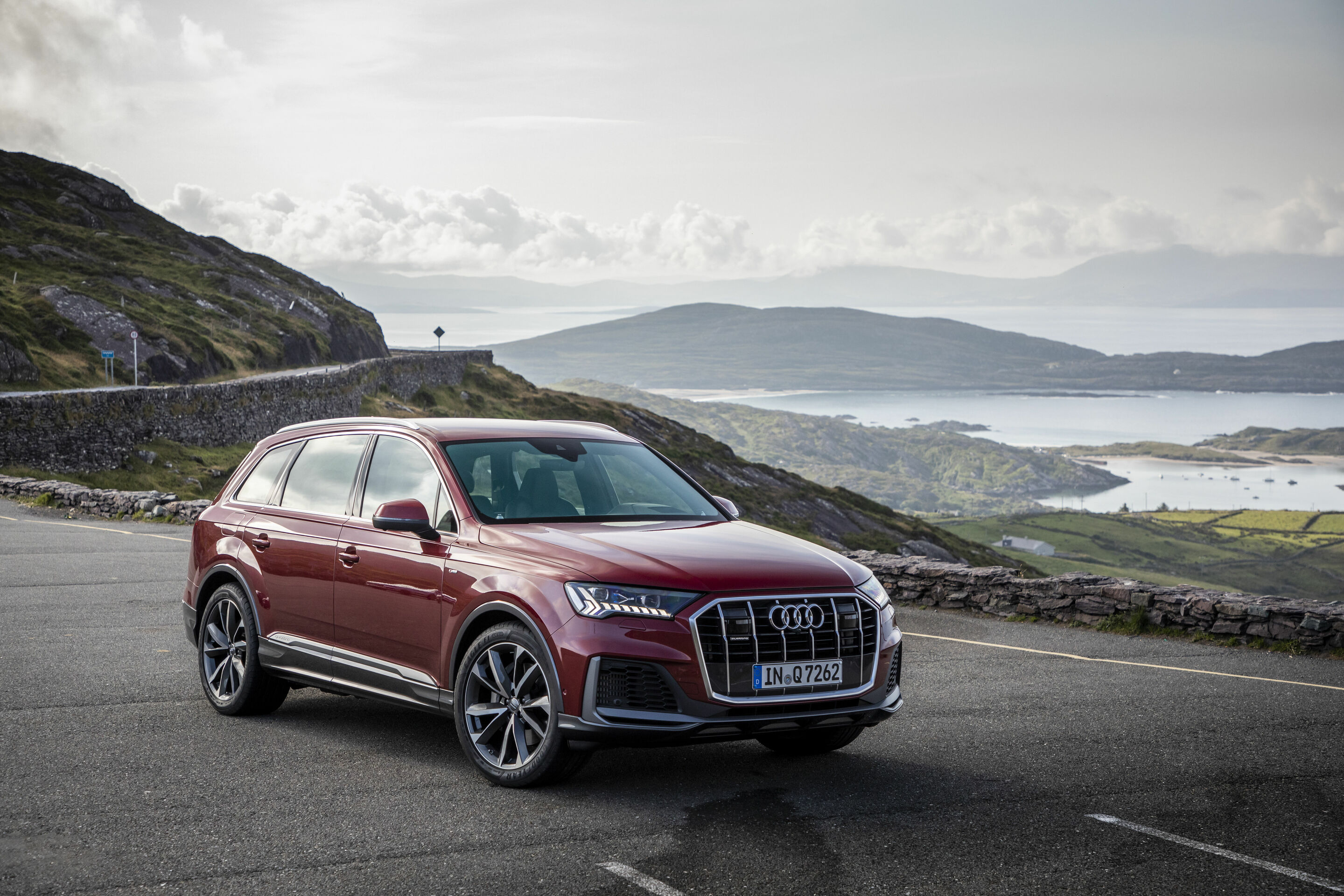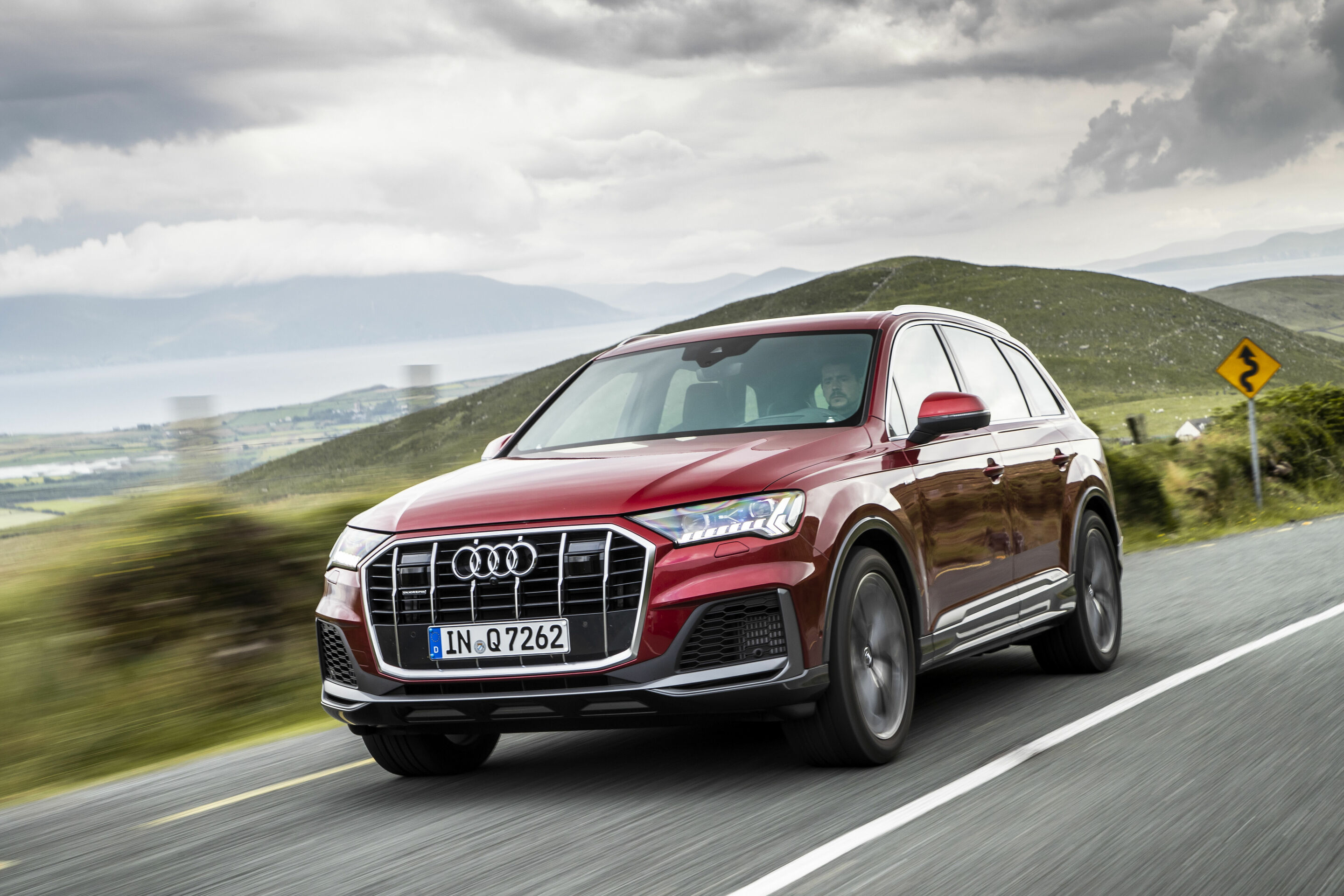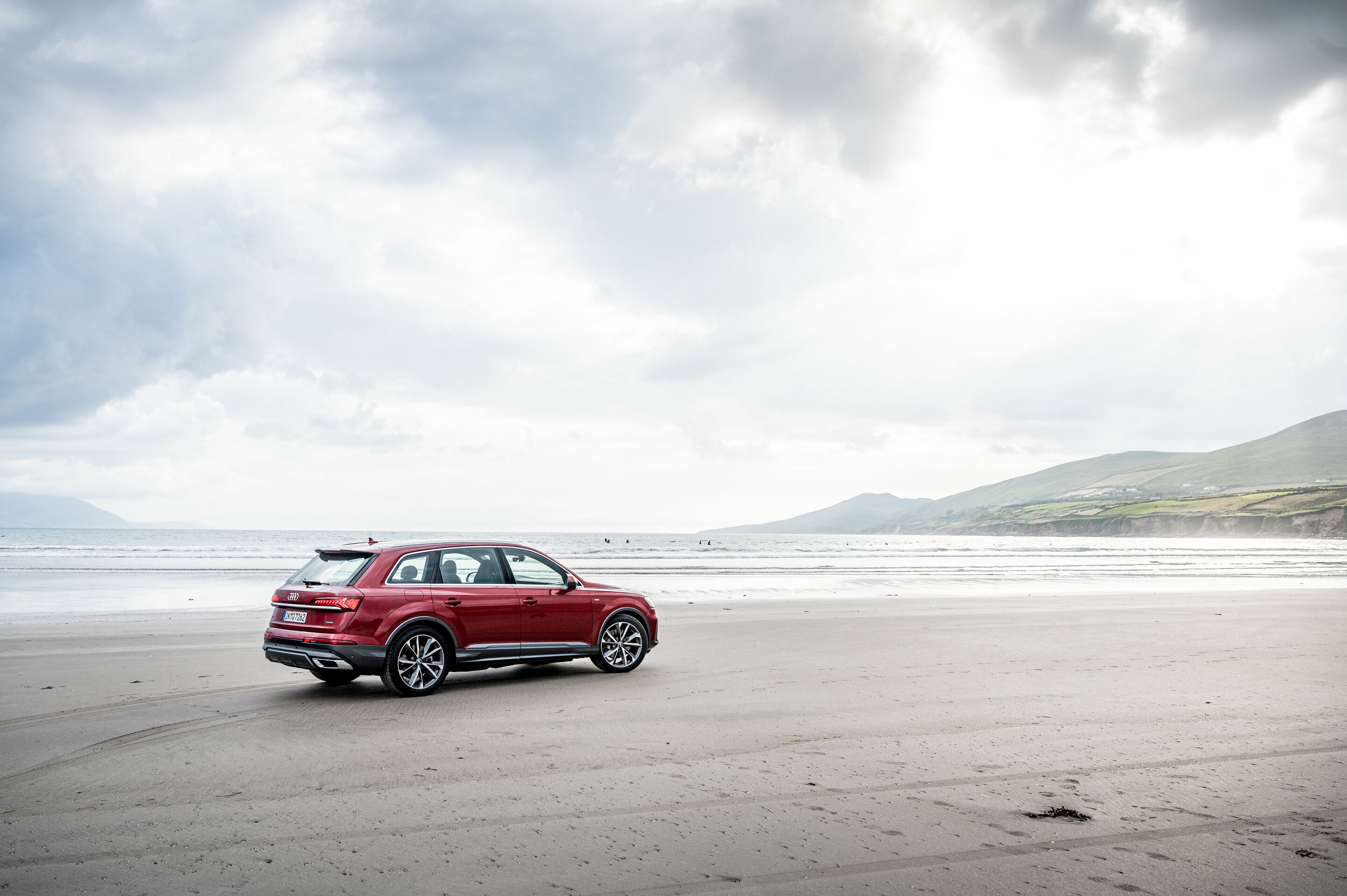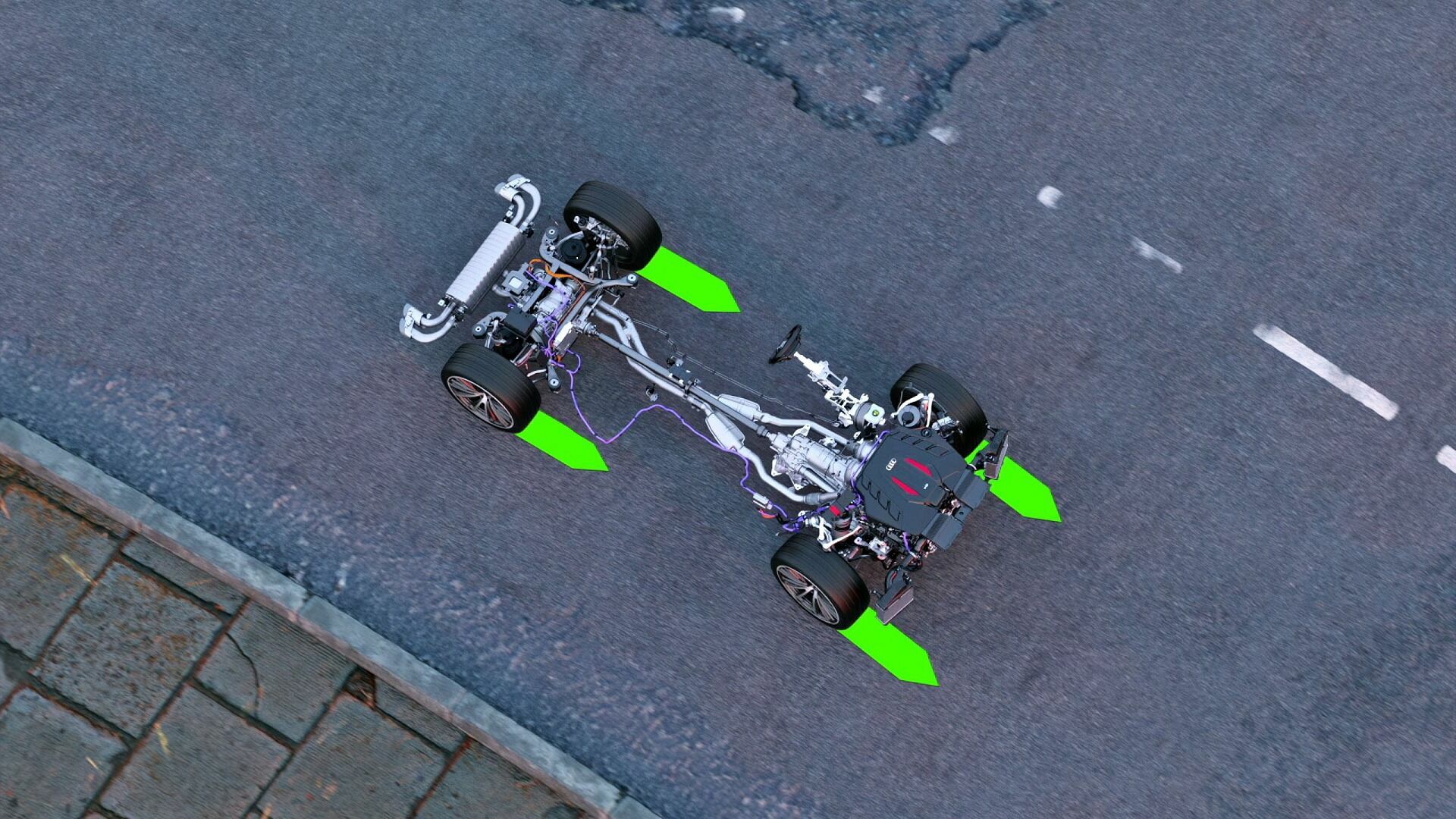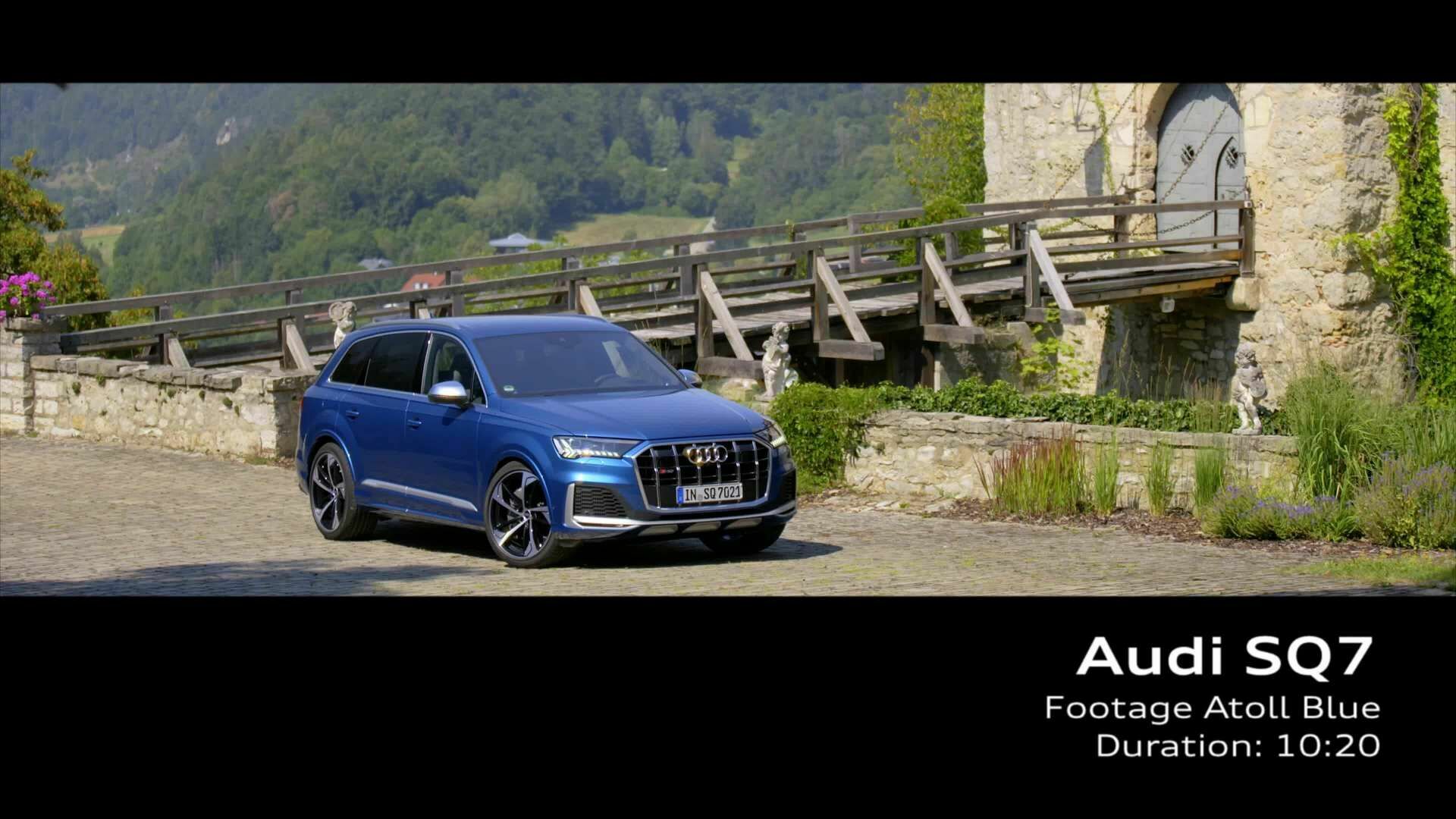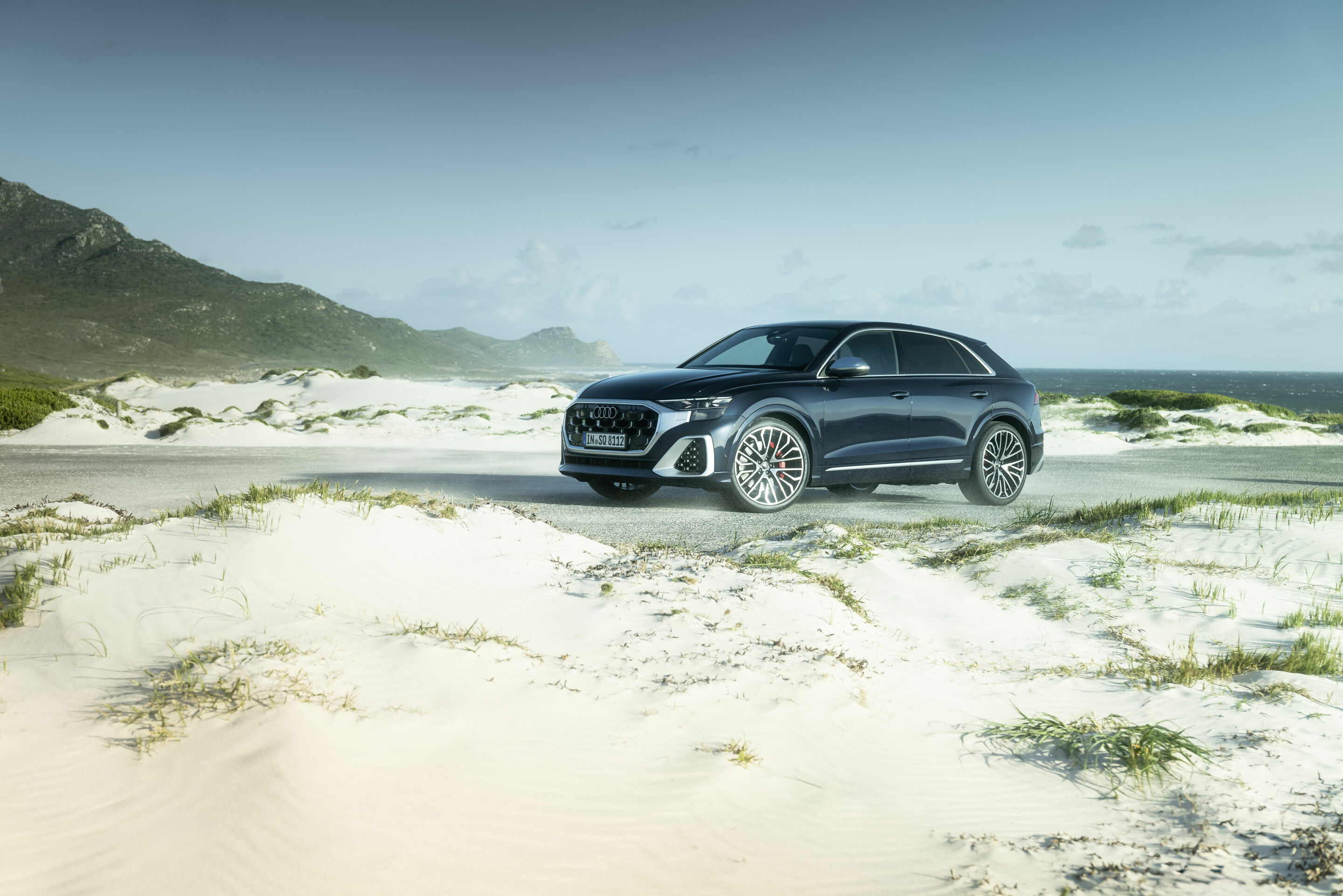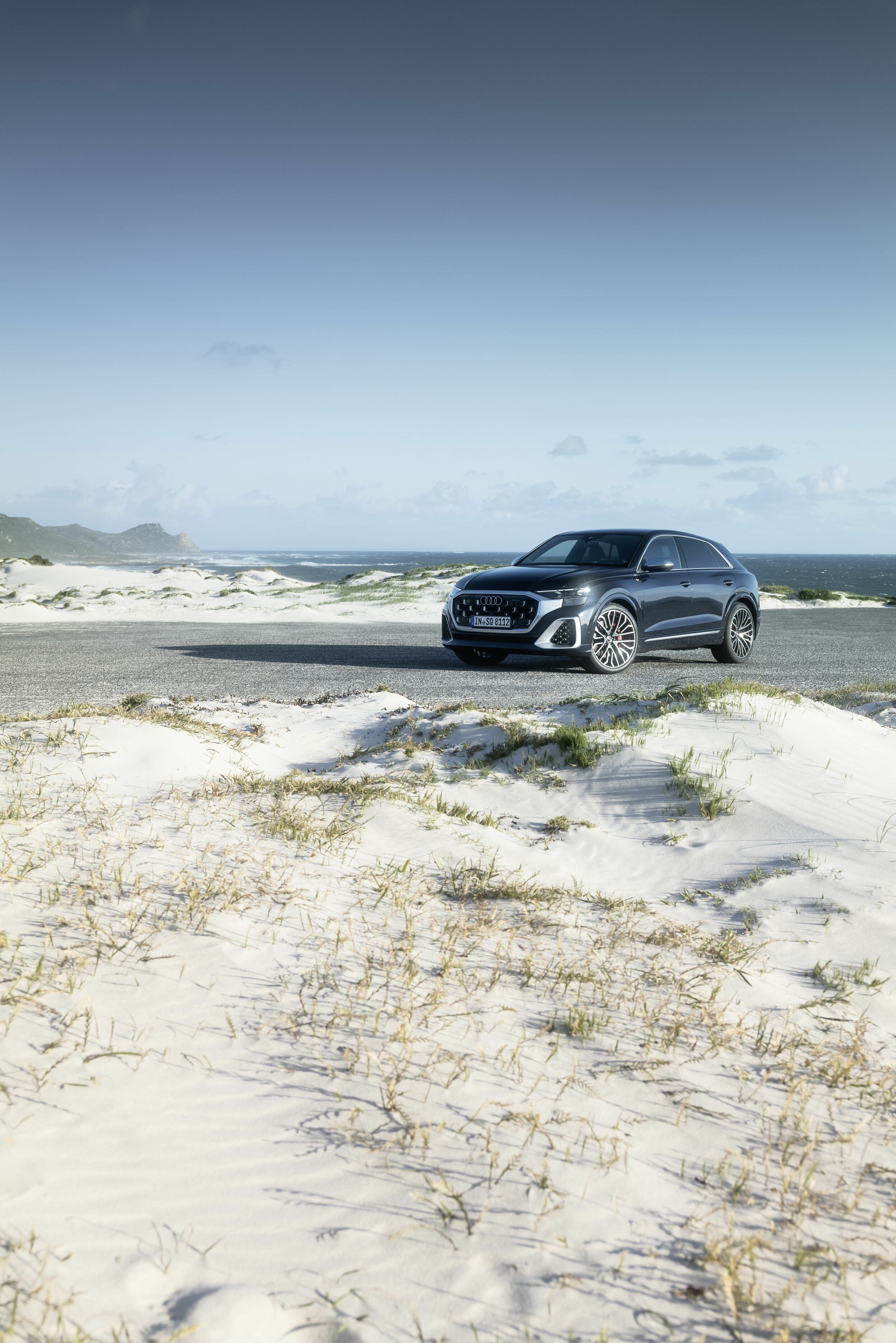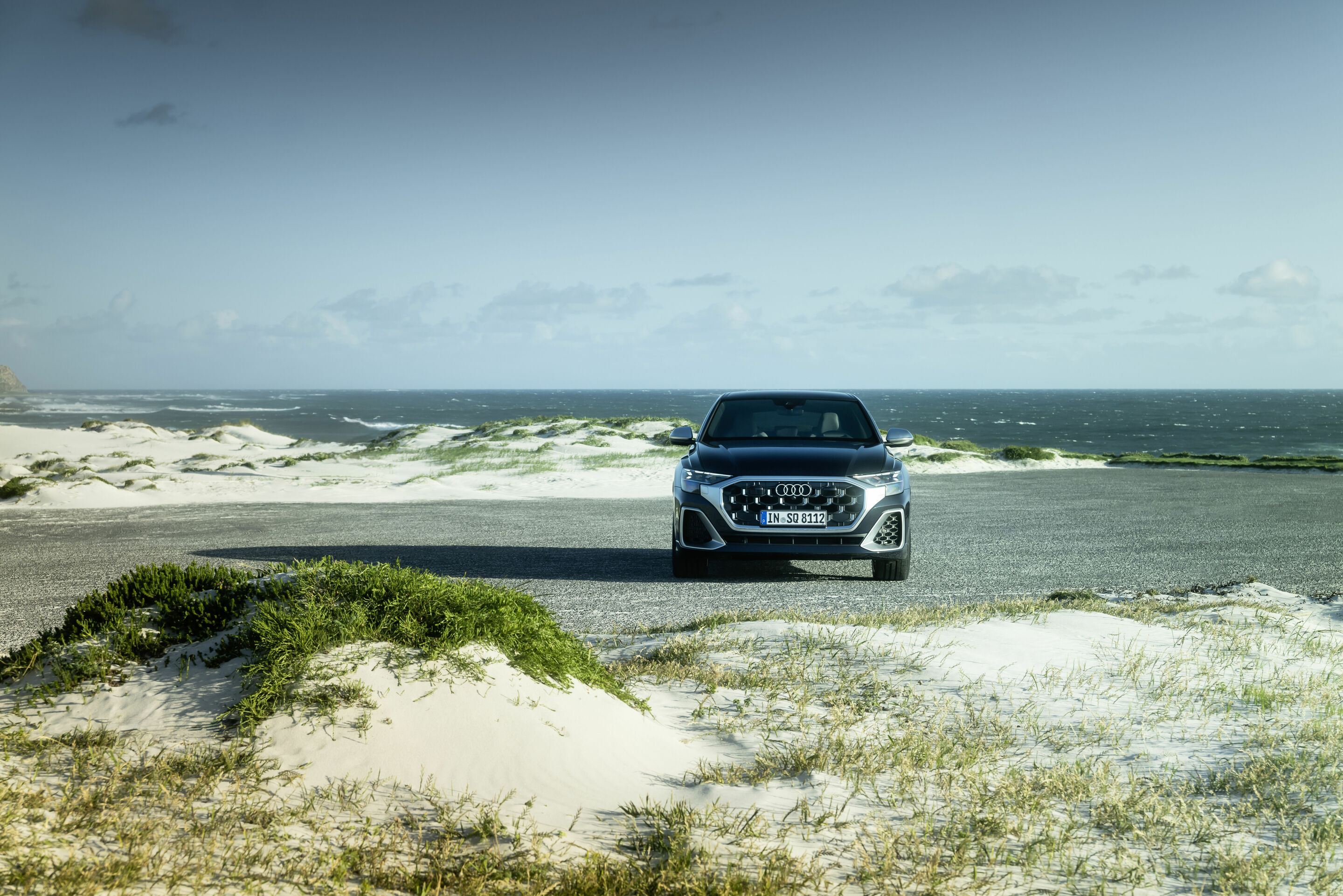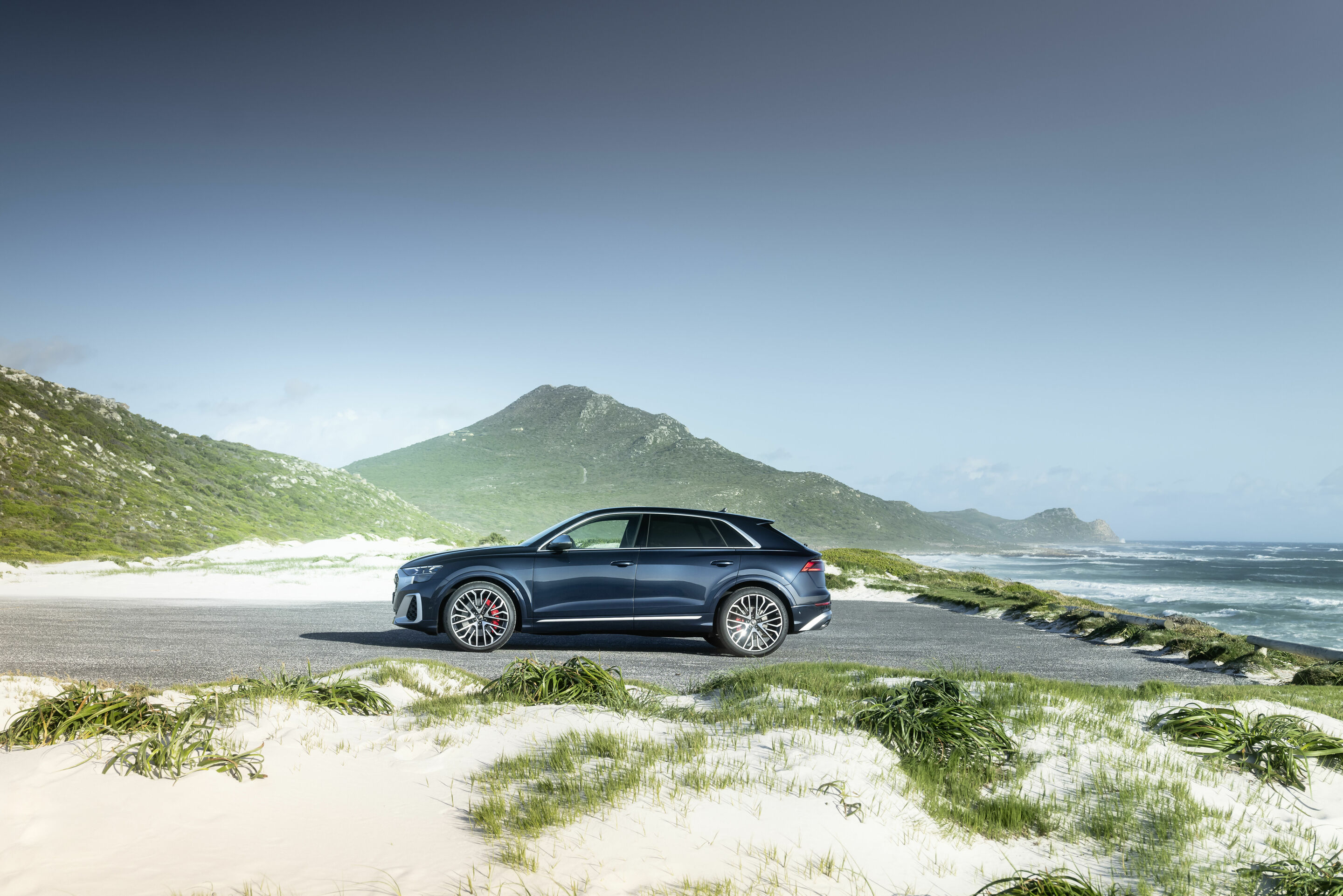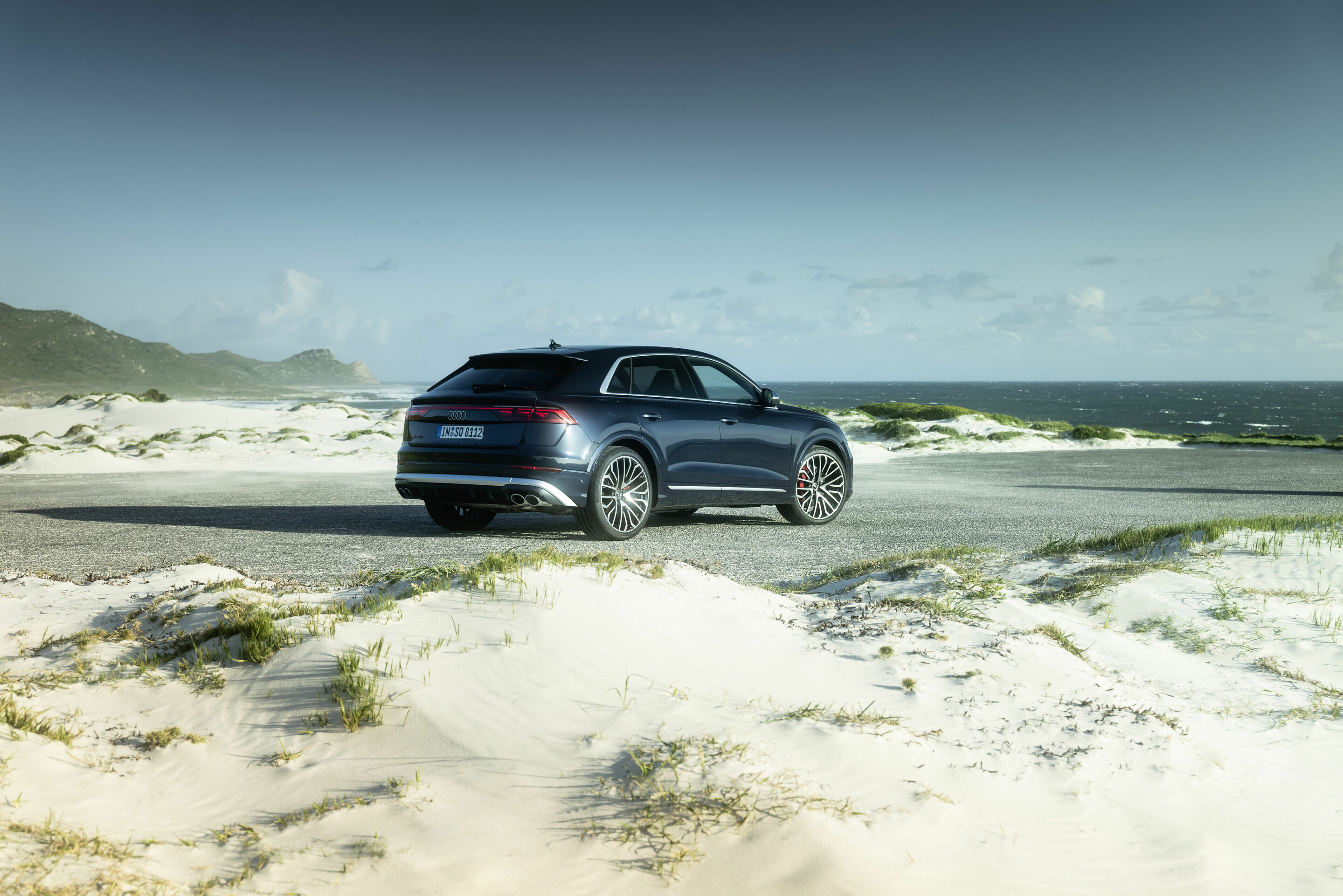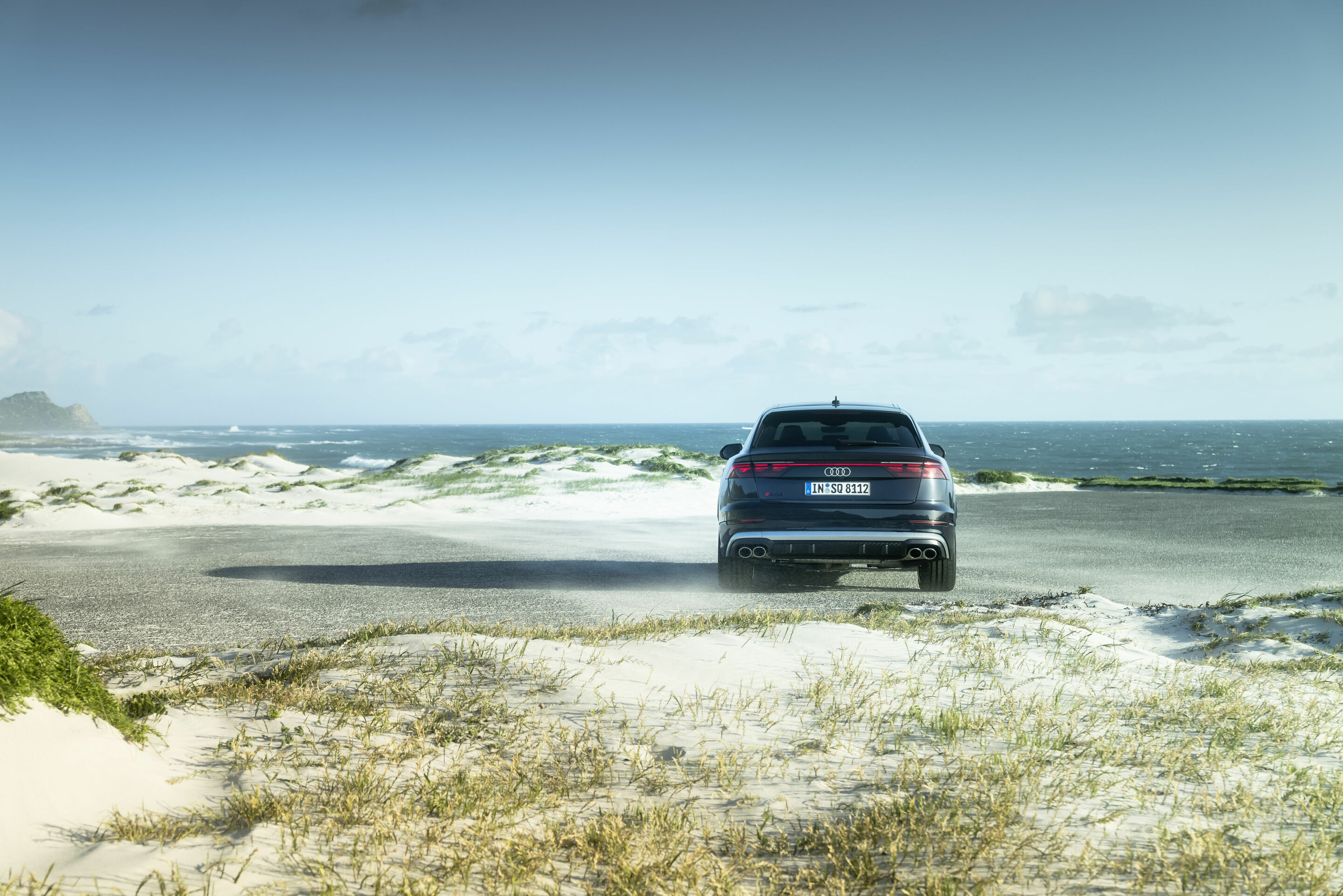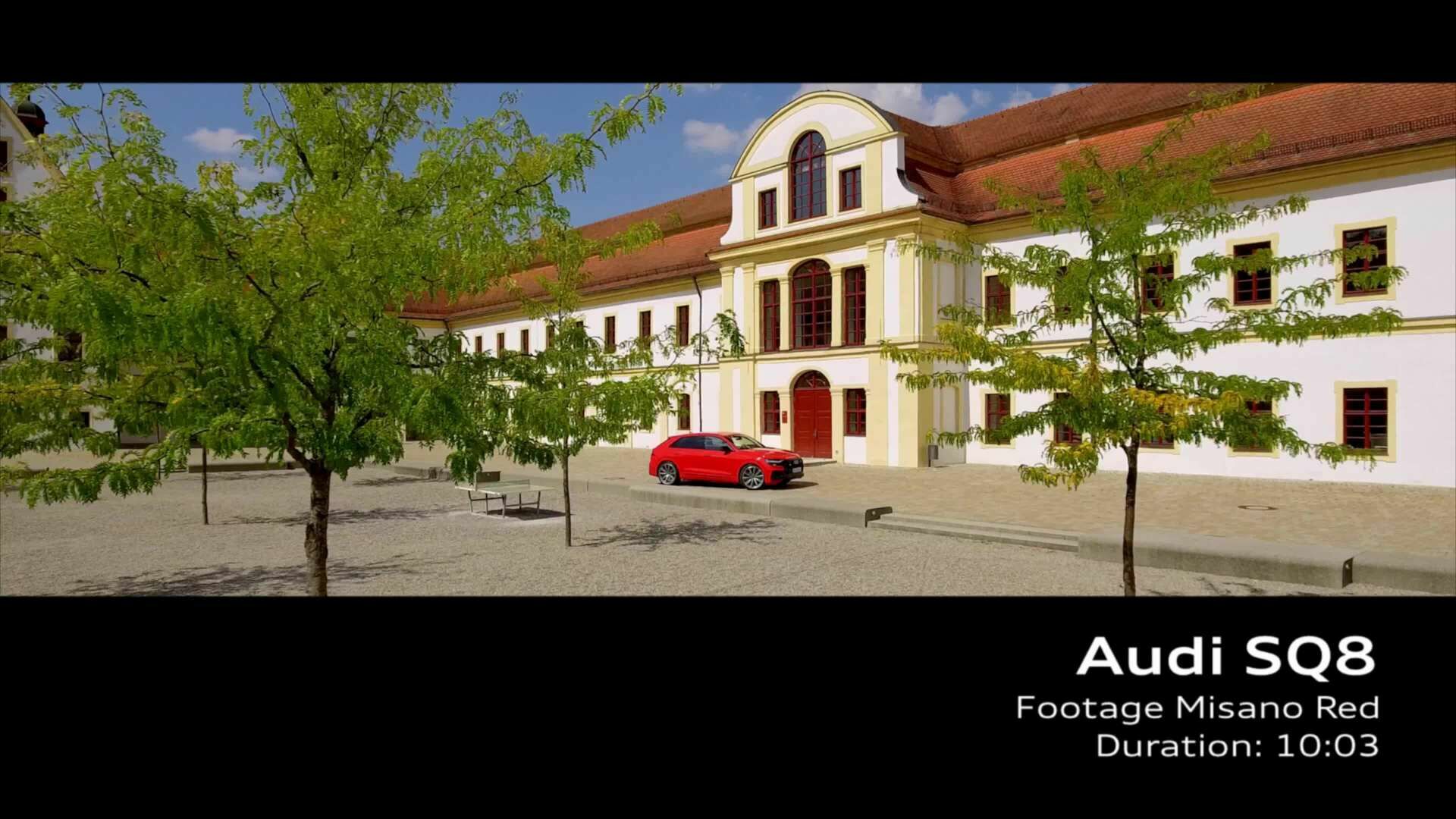Sporty character with a superior performance:
The Audi SQ7 and SQ8 with V8 TFSI gasoline engine
- 4.0-liter twin-turbo V8 with 373 kW (507 PS) and 770 Nm (567.9 lb-ft) of torque
- Suspension comes with all-wheel steering and sport air suspension as standard, and with a sport differential and roll stabilization as an option
- New connectivity and assist services, and automatic parking upon request
- Both models will be launched on the European markets in the fall
Audi is presenting the SQ7 and the SQ8 with new TFSI engines. The brand is thus responding to the worldwide trend toward sporty gasoline engines in the high-performance SUV segment. In terms of their suspension, the Audi SQ7 TFSI and the Audi SQ8 TFSI offer many high-tech components, and new connectivity and assist functions round off the technology package. The large S models will be launched on the European markets successively, starting in the fall of 2020.
373 kW (507 PS) and 770 Nm (567.9 lb-ft) of torque that is constantly available from 2,000 to 4,000 rpm: The 4.0 TFSI has an easy job with the Audi SQ7 and the Audi SQ8. The twin-turbo V8 accelerates both models from zero to 100 km/h (62.1 mph) in 4.1 seconds, and it takes just 3.8 seconds to sprint from 80 to 120 km/h (49.7–74.6 mph). The electronics limit the propulsion at 250 km/h (155.3 mph). Depending on the equipment, the SQ7 TFSI consumes between 12.1 and 12.0 liters of fuel per 100 kilometers (19.4–19.6 US mpg), which corresponds to CO2 emissions of 278 to 276 grams per kilometer (447.4–444.2 g/mi). For the SQ8 TFSI, these figures are also 12.1 to 12.0 liters (19.4–19.6 US mpg) and 276 to 275 grams of CO2 (444.2–442.6 g/mi)).
The 4.0 TFSI, which draws on 3,996 cm3 of displacement, is a high-tech engine. The cylinder barrels in the lightweight aluminum engine block are covered with a layer of iron that is applied by means of plasma spraying. It reduces the amount of friction and therefore also reduces both fuel consumption and wear. A special efficiency technology is activated when driving with a moderate style: The cylinder on demand (COD) system deactivates four cylinders temporarily by switching off the injection and ignition and keeping the intake and exhaust valves closed.
The cylinders must be well filled when the driver accesses the full performance of the 4.0 TFSI. For this purpose, the intake and exhaust camshafts can be adjusted by a crank angle of 50 degrees, depending on the operating conditions. This precisely controlled valve overlap ensures that the gas exchange and combustion chamber filling are always adjusted at lightning speed.
The two twin-scroll turbochargers, each of which supplies one cylinder bank with up to 1.5 bar of pressure (relative), also enable a gas exchange with virtually no loss. This results in harmonious power delivery and spontaneous response time. The cylinder heads are designed with the intake side on the outside and the exhaust side on the inside, while the turbochargers and their intercooler are fitted in the 90-degree inner V. This layout enables short gas paths between the outlet duct and the drive side of the exhaust turbine with minimal flow loss.
Its 1-3-7-2-6-5-4-8 ignition sequence gives the 4.0 TFSI a distinct sporty and sonorous sound. There is a flap in each tailpipe of the exhaust system that modulates the sound depending on the load and engine speed. Active engine mounts reduce the transmission of vibrations to the body. Their electromagnetic actuators act as loudspeakers: They emit impulses via the membranes that correspond exactly to the engine’s vibrations but are phase-shifted by 180 degrees. According to the law of interference, the two waves largely cancel each other out.
A quickly shifting eight-speed tiptronic and the quattro permanent all-wheel drive put the power of the 4.0 TFSI onto the road. A clutch in the automatic transmission engages freewheeling when the driver takes their foot off the accelerator. In regular driving operation, the purely mechanical center differential distributes the drive torque to the front axle and rear axle at a ratio of 40:60. If traction decreases at one axle, it directs most of the torque to the other axle – up to 70% to the front or up to 85% to the rear axle.
With the optional advanced suspension package, customers receive the sport differential in addition. When cornering at high speed, it shifts the torque between the rear wheels via two multi-plate clutches, with most of the torque being transferred to the wheel with better grip at the outside of the curve. This torque vectoring makes handling even more agile and stable: When turning in or accelerating, the large sports SUV is literally pressed into the curve and understeer is heavily minimized.
Audi provides the SQ7 TFSI and the SQ8 TFSI with two sporty suspension modules as standard. The adaptive air suspension sport integrates controlled dampers. It is capable of varying the ride height of the body by up to 90 millimeters (3.5 in). The all-wheel steering consists of two components. The front axle steering, which has a sporty and direct gear ratio of 13.3:1, increases the vehicle’s agility and maneuverability considerably.
A spindle drive influences the rear wheels: At low speed, it turns them by up to 5 degrees in the opposite direction, which makes it easier to maneuver. As of a speed of about 60 km/h (37.3 mph), it turns them slightly in the same direction for improved stability during fast changes of direction in particular.
The advanced suspension package includes another module: electromechanical active roll stabilization (EAWS). There is a compact electric motor on both axles that is coupled with a transmission. It divides the stabilizer into two halves. When driving straight ahead, it allows them to act largely independently of each other, which reduces sprung mass vibrations on uneven roads. At a sporty pace, the electric motor twists the two halves in opposite directions so that they act as a unit. The car now leans into the curve considerably less, and handling becomes even more taut. The drive energy for the EAWS is provided by a super capacitor that operates with a state of charge of 48 volts. The compact and light energy storage unit, which can absorb and emit strong currents in a very short time, supplies the two electric motors with a maximum power of 1.5 kW each.
As a central control unit, the electronic chassis platform (ECP) connects the controlled suspension systems, with the exception of all-wheel steering. The driver experiences this close and lightning-fast coordination as maximum handling precision. They decide how the controlled suspension components as well as the 4.0 TFSI and the tiptronic are to operate via the Audi drive select system. The driver can choose from seven driving profiles: comfort, auto, dynamic, efficiency, allroad, offroad, and individual.
As standard, the Audi SQ7 TFSI is fitted with 20-inch wheels and tires from the 285/45 series, while the SQ8 TFSI comes with 21-inch wheels and tires in the same format. Alternatively, Audi and Audi Sport provide other 21 and 22-inch wheels, and 23-inch wheels with tires in the 295/35 format are even available for the large SUV Coupé. Brake discs measuring 400 millimeters (15.7 in) in diameter are fitted to the front axle, with 350 millimeter (13.8 in) discs on the rear axle. The black brake calipers – optionally also available in red – feature an S logo on the front axle. Upon request, Audi will also install a brake system with particularly powerful and durable carbon-fiber ceramic discs. They have a diameter of 420 millimeters (16.5 in) at the front and 370 millimeters (14.6 in) at the rear. The calipers are painted in anthracite gray.
Sporty look: the exterior design
Thanks to its S-specific details, the special status of the Audi SQ7 TFSI and the Audi SQ8 TFSI becomes apparent at first glance. The front features double slats in the Singleframe and a distinctly three-dimensional blade in the bumper, while the side air inlets are filled with a honeycomb grid.
At the side, the exterior mirror housings in aluminum look catch the eye, while the underbody protection with its powerful design, a honeycomb grid insert, and the four characteristic tailpipes provide highlights at the rear. Some attachments are designed in matt silver, including the frame of the Singleframe, which is designed as a wide mask in the SQ8 TFSI. If the customer ordered the black styling package, the frame as well as other parts are painted black.
Sporty character: interior and equipment
The elegant sporty look is continued in the spacious interior of the Audi SQ7 TFSI and the SQ8 TFSI. The sport seats are upholstered with leather and Alcantara in black or rotor gray. Their backrests feature S embossing and color-coordinated contrasting stitching complements the appearance. The inlays are made of matt brushed aluminum. They can optionally be made of carbon or gray, high-gloss oak veneer. The series production scope also includes illuminated door sill trims with aluminum inlays with the S logo at the front. The pedals, the footrest, and the loading sill protector are made of stainless steel.
Upon request, Audi will install sport seats plus with integrated head restraints and pneumatically adjustable side bolsters. Their covers are made of top-quality Valcona leather and feature a rhombus pattern. Arras red is available as a further color option. The S sport seats can be further refined with ventilation and a massage function. A third seat row is available for the Audi SQ7 TFSI (combined fuel consumption in l/100 km*: 12.1–12.0 (19.4–19.6 US mpg); combined CO2 emissions in g/km*: 278–276 (447.4–444.2 g/mi)). The contour/ambient lighting package, which is also available as an option, illuminates contours and surfaces in 30 colors that can be adjusted to the driver’s individual taste via the MMI.
New computing power: infotainment and controls
In terms of controls, infotainment, and connectivity, the Audi SQ7 TFSI and the Audi SQ8 TFSI are equipped with state-of-the-art technology. The MMI touch response control system integrates two large displays in the center of the instrument panel. They have a 10.1-inch and 8.6-inch diagonal, respectively, and respond with haptic and acoustic feedback to all finger input. The menu structure makes it easy to control with flat hierarchies. The user can configure the interface of the upper display such that they can follow multiple apps at the same time.
The two S models provide a natural language voice control system as a second control level, which understands many formulations from everyday language and accesses the knowledge of the cloud to respond to many requests. The driver can activate it by saying “Hey Audi.”
A head-up display that projects important information onto the windshield is available as an option. The Audi virtual cockpit plus with S-specific views is controlled via the multifunction steering wheel and serves as the standard display instrument. The driver can activate different screens, including an “S-Performance” look. It shifts the focus to the rev counter and displays the power output and torque as percentages.
There is a new, high-performance main unit – the third generation modular infotainment platform (MIB 3) – behind the control and infotainment concept. It works with the communication box, which executes all tasks relating to connectivity and has an integrated Wi-Fi hotspot. The SQ7 TFSI and SQ8 TFSI are equipped with the top infotainment system MMI navigation plus as standard, which exploits the full potential of the MIB 3. The navigation system offers satellite images from Google Earth and takes lane-specific information on the traffic flow and predictions on the development of the traffic situation into account.
Audi connect: top-caliber connectivity
The services in the Audi connect portfolio offer customized information and intelligent assistance. For example, the Car-to-X services help with finding free parking spots on the roadside or allow the driver to surf the green wave by communicating with traffic lights. Online media streaming introduces the offering of major music portals into the car.
If the car is driven by multiple drivers, up to six users can save their individual settings – from frequently selected destinations to their preferred lighting – in separate profiles. The data is uploaded to the customer’s myAudi account in the cloud and stored there. The car adjusts the individual settings when the driver’s door is opened. This convenient personalization feature comes as standard with the Audi SQ7 TFSI and the Audi SQ8 TFSI. The Audi connect key, which authorizes users to lock and unlock the car and start the engine via their Android smartphone, is available as an option. The data is exchanged via Near Field Communication (NFC) here.
Attractive hardware modules supplement the infotainment portfolio. The Audi smartphone interface embeds iOS and Android smartphones on the MMI display in their native environments Apple CarPlay and Android Auto. The Audi phone box couples smartphones with the car’s antenna and charges them inductively provided that the phone is equipped with this function. The Bang & Olufsen Advanced Sound System with 3D sound integrates an amplifier that outputs 1,920 watts and actuates up to 23 speakers.
Convenience equipment such as four-zone automatic air conditioning, a power assistance function for closing the doors, and the air quality package with scent and an ioniser complement the offer. The optional HD Matrix LED headlights are a further piece of top-of-the-line technology: Thanks to their intelligent regulation, they illuminate the road with maximum brightness and precision in any situation. In the SQ7 TFSI, they are equipped with the Audi laser light in addition, which almost doubles the range of the high beam lights.
Watching from the outside as the car parks itself: the driving safety systems
The assist systems make driving the Audi SQ7 TFSI and the SQ8 TFSI feel even more confident and comfortable. Safety systems such as Audi pre sense front are included as standard, while some of the other systems are available either individually or as part of the “City” and “Tour” packages.
The adaptive cruise assist takes over steering, accelerating, and decelerating for the driver in many situations. The improved restarting comfort is a new feature: Even after a longer standstill, the adaptive cruise assist gets the car start rolling again if the car in front starts moving. A capacitive steering wheel will follow later. It takes only a slight touch for the car to detect that the driver is taking responsibility for steering and automatic lateral guidance can remain active.
The efficiency assist supports a fuel-efficient driving style by notifying the driver as to when it would make sense to take their foot off the gas. In the city, systems such as the intersection assist, rear cross traffic assist, exit warning, and the surround view cameras add to the portfolio.
The park assist plus is a new feature in the two S models. It maneuvers the car into and out of a parallel or bay parking space at the push of a button, accessing the steering, gas, brake, and tiptronic while doing so. The driver sits in the car and is responsible for the maneuver.
Maneuver assist is a further new feature that the new S models will be equipped with at market launch. At speeds below 10 km/h (6.2 mph), it can avoid maneuvering collisions by means of brake interventions while driving both forwards and backwards. The system detects objects all around the car that are larger than around 20 centimeters (7.9 in), for example parking vehicles or pillars in parking garages. To do this, it uses the ultrasonic sensors and the optional surround view cameras. If the situation calls for it, it brakes the car down to a standstill.
The Audi SQ7 TFSI and the SQ8 TFSI will be introduced to the European markets in the fall. In Germany, they will be available from EUR 93,287.40 and EUR 101,085.72, respectively.
